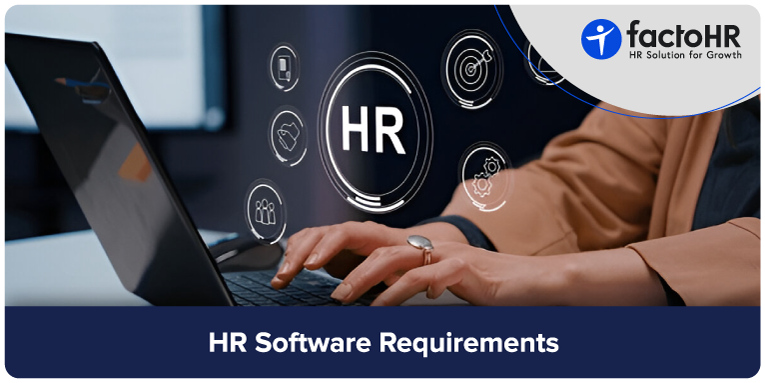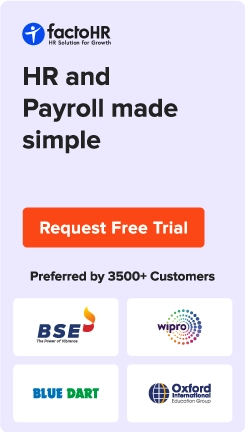HR Software Requirements: Identify Your Needs

Table of Contents
Finding an HR software that is the perfect fit for a specific business is essential, especially if they are seeking to streamline HR tasks and enhance overall efficiency. Before choosing any software, it’s important to take a moment to understand your HR needs clearly. Knowing what your company truly requires helps you avoid spending on features you don’t need and ensures you get tools that can really improve your HR processes.
HR software helps managers and business owners automate repetitive tasks, manage employee data, ensure compliance, and enhance employee engagement. The right HR system can reduce administrative burden and support strategic decision-making. It helps manage everything from recruitment and onboarding to performance tracking and payroll. However, no two businesses are the same, and what works for one may not suit another.
That is why aligning software capabilities with specific HR challenges and goals is considered necessary. Defining your needs for a robust HRIS, ATS, payroll tool, or performance management solution helps you make an informed, cost-effective choice. This HR Software requirement guide will help you understand various human resource management software features and help you match them to your business’s operational and strategic needs.

Understanding the Various HR Tools
Choosing the right HR software begins with understanding the various types and determining which one best suits your needs. Each HR software tool serves a specific purpose, and knowing how they work helps you set up your HR processes to support your business goals.
HRIS (Human Resources Information System)
An HRIS is a centralized platform that stores and manages employee information. It streamlines administrative tasks and minimizes paperwork by keeping records of personal details, employment history, and benefits in a single location. A good HRIS helps you keep organized employee records and adhere to the regulations your business must follow. It’s the foundation of most HRIS software setups, especially for those exploring key benefits of HRIS that improve overall HR operations.
ATS (Applicant Tracking System)
An ATS simplifies the hiring process. It helps HR teams manage job postings, track applications, and efficiently filter candidates. If recruitment is unavoidable for your human resources needs, an ATS will be considered a key feature. It saves time and ensures a smooth experience for both recruiters and applicants.
Payroll Management Systems
Salary calculations, deductions, and tax filings are some of the tasks that are managed accurately with the help of payroll software, ensuring timely and error-free payslip generation. This type of software platform is essential for compliance and accuracy. For businesses with growing teams, this is one of the most critical features to look for in human resource management software.
Performance Management Software
This software helps track employee goals, conduct reviews, and support productivity growth. It enables continuous feedback and performance analysis, aligning team efforts with business objectives.
When you understand what each tool does, choosing HR software that matches your business needs becomes easier. The goal is to select software that addresses your primary HR challenges.

Assessing Your HR Needs
Before choosing any HR software, review your existing HR processes. A clear understanding of what is functioning well and what needs improvement will help you identify the right features and select a solution that fits your organization’s needs.
Screening Questions for Selecting HR Software
Start by asking yourself simple but key questions:
Are you spending too much time on manual HR tasks?
Is employee information scattered across spreadsheets?
Is it challenging to track leave, payroll, or performance?
These questions highlight the human resources requirements that your software must address.
Evaluate Current Processes
Take a close look at your current HR workflow. From onboarding to payroll and performance reviews, how efficient are your processes? This review will help match your HR system requirements with tools that improve daily tasks.
Identify Pain Points and Goals
What frustrates your HR team the most? Slow hiring? Payroll errors? Lack of insights? Identifying these pain points and establishing clear objectives will help determine the essential features of your human resource management software.
Consider Company Size and Growth
Every business has unique needs. While a small business might benefit from essential features, a growing company may aspire for a scalable HR solution. Starting with factoHR’s HR software designed for small businesses can truly streamline management and support your growth journey!
Prioritize Needs
Not every feature is a must-have. List your top priorities—payroll, recruitment, or performance tracking. This allows you to focus on the HRMS features that are most relevant to your business.
Choosing the right HR software starts with understanding your own needs. The clearer your understanding, the greater your chances of selecting a system that effectively supports your team and business.
Defining Your HR Software Requirements
Once the HR needs have been identified, the next step is to turn those insights into a clear list of HR software requirements. This helps you evaluate and compare solutions effectively.
List Functional Requirements
List your functional requirements and the core tasks you want the software to perform. When looking for an HR software that is an all-in-one solution, consider features like employee data management, payroll processing, attendance tracking, recruitment, and performance reviews. Start by writing down your HR workflow, finding the gaps, and listing features to improve efficiency. Modern HR tools are designed to meet the evolving needs of the workforce. At its core, HR software supports a wide range of essential human resources (HR) functions.

Specific Requirements for Various Types of HR Software
Different HR software tools serve various purposes. Here is a brief look at what to look for in each type:
Payroll and Benefits Software Requirements
This type of software should handle salary processing, tax calculations, payslips, and statutory compliance efficiently through a streamlined payroll process. Good software should also support flexible benefit structures.
Recruitment Software Requirements
It should support resume management, job posting, applicant tracking, and interview scheduling. These elements of recruitment software hold great importance, as they expedite and enhance the hiring process through automation and analytics.
Performance Management Software Requirements
Look for software that enables goal setting, employee feedback, and performance management through continuous performance reviews. A user-friendly dashboard and customizable review cycles add significant value.
Data Security & Compliance Requirements
Any selected software should adhere to essential security standards and privacy regulations, such as ISO 27001, SOC 2, and GDPR, to safeguard employee information.
Documentation and Clarity
Vendors should provide clear user guides, onboarding support, and policy documentation to help HR teams maximize the benefits of the software.
Align with Budget and Resources
Ensure the software aligns with your budget and delivers a strong return on investment (ROI) through automation and time savings.
Compatibility with Existing HR Systems
Select a solution that easily integrates with your existing tools for effective HR management. Easy HR integration improves efficiency and streamlines workflow.
Flexibility and Adaptability
Choose software capable of scaling with your business growth and adapting to evolving HR policies and needs.

Sum Up
Choosing the right HR software starts with knowing what your business truly needs. Different types of HR tools, such as HRIS, payroll systems, recruitment software, and performance management solutions, serve distinct purposes. However, the most important step is to carefully evaluate your organization’s challenges to identify any issues affecting your team and determine if current processes are limiting productivity. Identifying these gaps is the first step to building strong, future-ready HR software requirements.
A thoughtful self-assessment lets you prioritize what matters most. Whether improving hiring speed, ensuring accurate payroll, or tracking employee performance, your HR system requirements should reflect these priorities. Company size and growth also play a role. While smaller teams may require basic features, larger or rapidly growing businesses should consider scalable and flexible solutions that meet long-term HRIS system needs.
Clearly outlining your requirements helps in selecting the key features of human resource management software that are necessary, rather than those that are simply desirable. Remember to consider integration with existing systems, data security, compliance, and budget. These human resources requirements form the core of any wise software decision.
Meet factoHR – the HR Software That Fits Just Right
factoHR is the all-in-one HR software that adapts to your needs, whether you’re a small team or a growing enterprise. We invite you to book a demo and experience how factoHR can transform your operations. Let us help you manage, engage, and grow your team to better match with the right HR software.
How Long does HR Software Implementation Usually Take?
HR software implementation usually takes 3 to 6 months, depending on the system’s complexity, company size, and customization needs.
How Much Should I Budget for HR Software?
You should budget based on your company size, required features, and whether you need a basic system or a full-suite HR solution with advanced tools.
What Data Security Standards Should the Vendor Meet?
Vendors should meet 4–5 key data security standards, such as ISO 27001, GDPR, and SOC 2. factoHR follows the SOC 2 standard, ensuring secure and reliable data handling.
Grow your business with factoHR today
Focus on the significant decision-making tasks, transfer all your common repetitive HR tasks to factoHR and see the things falling into their place.

© 2025 Copyright factoHR


